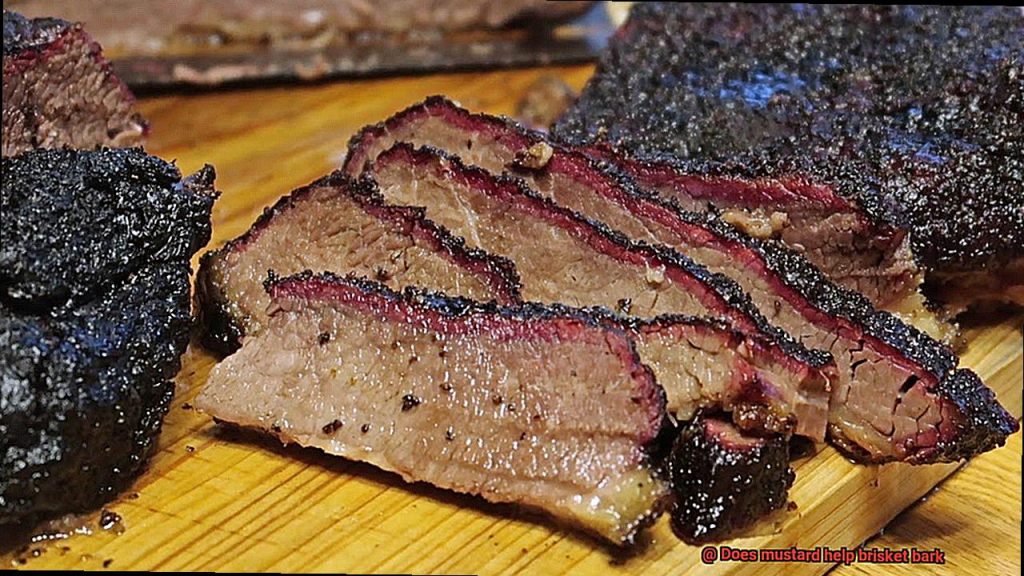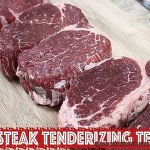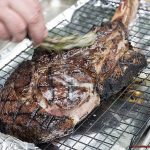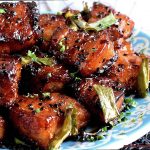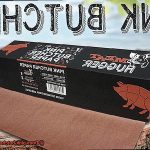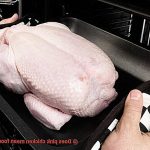Hey there, meat lovers and barbecue enthusiasts. If you’re like me, you’re always on the hunt for ways to elevate your brisket game. And if you’ve spent any time browsing online forums or chatting with fellow pitmasters, you’ve likely come across the age-old question: does mustard help brisket bark?
Some folks swear by slathering their briskets in this tangy condiment before applying their rub. Others scoff at the idea, insisting that it’s just a waste of perfectly good mustard. But as someone who’s spent countless hours tinkering with different techniques and flavor profiles, I can tell you that there’s more to this debate than meets the eye.
In this blog post, we’ll take a deep dive into the science and myths behind using mustard to enhance your brisket bark. We’ll explore everything from its impact on smoke penetration to its ability to create that coveted crusty exterior (aka “bark”). And by the end of our journey together, you’ll be armed with all the knowledge you need to decide whether or not to give mustard a try during your next cookout.
So, grab a cold beverage (or maybe even a squirt bottle of yellow stuff), fire up your smoker, and let’s get started.
Contents
What is Mustard?
Mustard is not just a condiment, but a versatile ingredient that has been used for centuries in culinary and medicinal practices. It is made by crushing mustard seeds and mixing them with vinegar, water, and various other ingredients to create a paste or sauce that can be used as a topping or ingredient in a variety of dishes. From sandwiches and hot dogs to salad dressings, marinades, and sauces, mustard adds a tangy kick to any dish.
There are many varieties of mustard available to cater to different taste preferences. For instance, yellow mustard is mild and tangy, while dijon mustard is more pungent and spicy. Other varieties include honey mustard, whole-grain mustard, and spicy brown mustard. With such variety, there’s no excuse for anyone not to enjoy the taste of mustard.
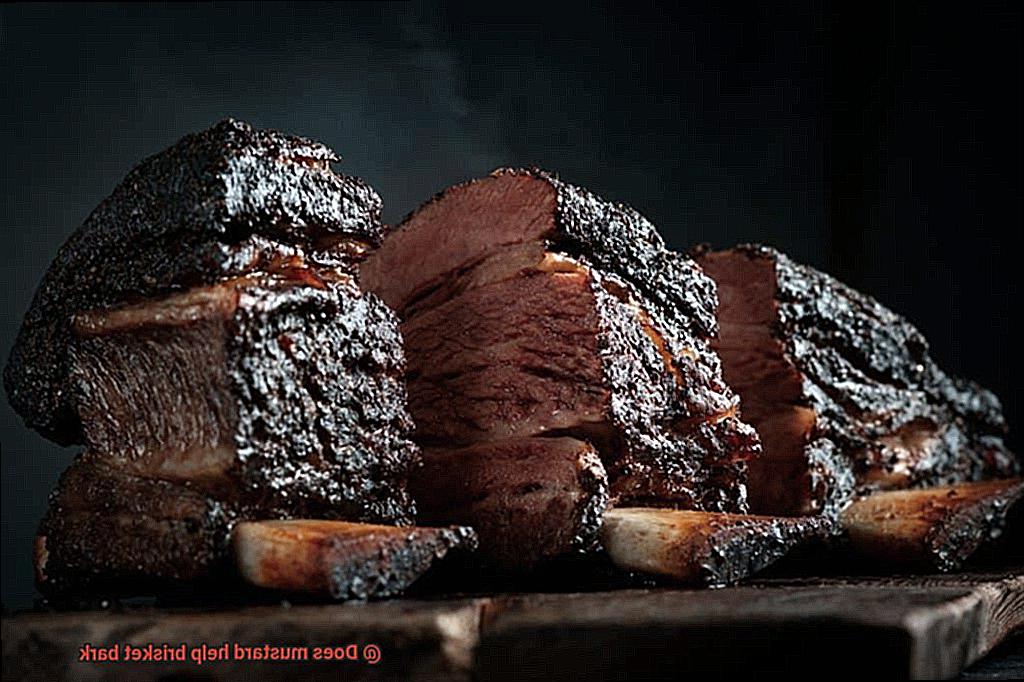
In the context of grilling brisket, mustard is often used as a binder for dry rubs. The sticky adhesive helps the rub adhere to the meat, creating a more even and consistent bark on the outside of the brisket. Additionally, the acidity in mustard can help break down the surface of the meat, allowing for better absorption of flavors from the rub. However, using mustard is not the only way to achieve a great bark on your brisket, as many pitmasters have had success without it.
Aside from its culinary uses, mustard is believed to have health benefits. It has antioxidant properties and may help to reduce inflammation in the body. Moreover, it has been used in traditional medicine to treat coughs, colds, and other respiratory ailments.
How Does Mustard Help Brisket Bark?
Look no further than a surprising ingredient: mustard. Yes, you read that right – mustard is not just a condiment anymore, but also a secret weapon in achieving that perfect crust on smoked brisket.
But how does mustard help brisket bark, you ask? First, it acts as a binder that helps the dry rub stick to the meat, creating an even coating that enhances flavor. Mustard contains natural emulsifiers that ensure the rub stays put during smoking, so you don’t have to worry about uneven coverage.
In addition to its binding properties, mustard has a slightly acidic taste that breaks down the tough muscle fibers in the meat. This leads to a more tender and juicy finished product that will have your guests licking their fingers. And as the mustard cooks, it caramelizes, creating a barrier between the meat and the dry rub that protects it from drying out while still allowing for smoke penetration.
It’s important to note that while mustard can be a helpful tool in creating brisket bark, it’s not essential for great results. Some pitmasters prefer to skip the mustard altogether and apply their dry rub directly to the meat. Ultimately, it comes down to personal preference and experimentation to find what works best for you.
The Benefits of Using Mustard on Brisket
Look no further than the condiment aisle for a game-changing ingredient: yellow mustard. This humble condiment can take your smoked brisket to the next level, with benefits that go beyond its tangy flavor.
First and foremost, using mustard as a binder for your rub helps it stick to the meat like glue. The acidity in the mustard penetrates the surface of the meat, creating a sticky surface for the rub to cling to. This ensures that your rub stays in place during the smoking process, resulting in a flavorful crust on the outside of the brisket that will have your taste buds singing.
But that’s not all – using mustard on brisket also helps to seal in moisture. The acid in the mustard breaks down some of the connective tissues in the meat, allowing it to absorb more moisture. This means that your brisket will be juicier and more tender than ever before, with every bite bursting with flavor.
And let’s not forget about flavor – while mustard itself doesn’t have a strong taste, it can enhance the flavors of your rub and smoke. The combination of spices and smoke can create a unique and delicious flavor profile that will make your brisket stand out from the rest. Think of it as an extra layer of seasoning that takes your brisket to new heights.
To use mustard on your brisket, simply slather a thin layer over the entire surface before applying your rub. Be sure to use a plain yellow mustard with no added flavors or sugars for best results. Trust us – your guests will be licking their fingers and begging for seconds.
The Disadvantages of Using Mustard on Brisket
You may have heard about using mustard as a binder for your rub, but before you slather it on, consider the potential disadvantages.
One of the main concerns with using mustard on brisket is that it can leave a strong mustard flavor on the meat. While some may enjoy this bold taste, others may find it overpowering and detracting from the natural flavor of the beef. Furthermore, if you’re cooking for a group, there may be individuals who are allergic to mustard or simply not fans of its taste.
In addition to affecting the flavor profile, using mustard can cause the meat to become overly salty. Mustard often contains a substantial amount of salt, which can be absorbed by the meat during cooking. This can result in a brisket that’s too salty for many palates.
Lastly, using mustard can be a messy and time-consuming process. Applying a layer of mustard to your meat before adding your rub requires extra effort and creates more dishes to clean up after cooking. Moreover, some people find that the mustard creates a sticky residue that’s challenging to clean off their grill or smoker.
While using mustard on brisket can enhance flavor and create an amazing bark, it’s important to weigh these potential drawbacks before deciding whether or not to use it in your cooking process. To recap, here are the disadvantages of using mustard on brisket:
- Strong mustard flavor
- Potential allergies or dislikes
- Overly salty meat
- Messy and time-consuming application process
Alternatives to Using Mustard to Enhance the Bark of Brisket
Or maybe you have dietary restrictions that prevent you from using it. Fear not, because there are plenty of alternatives available that can help enhance the bark of your brisket without compromising on flavor or texture.
One popular alternative is Worcestershire sauce. This tangy sauce not only helps the rub adhere to the meat but also adds a unique flavor profile to the bark. A light coat of Worcestershire sauce brushed onto the brisket before applying your rub can work wonders in enhancing the flavor and texture of your bark.
If you’re feeling adventurous, try using olive oil as a binder. This versatile ingredient not only helps create a crispy crust on the surface of the brisket but also adds a subtle depth of flavor to the meat. A light coat of olive oil brushed onto the brisket before applying your rub ensures that your bark will be flavorful and crispy.
For those who like to spritz their brisket during cooking, consider using apple cider vinegar. Spritzing your brisket with apple cider vinegar every hour or so can help enhance the flavor of the bark and create a nice crispy texture. It also helps keep the meat moist while cooking.
And for those who prefer a more straightforward approach, some pitmasters skip using a binder altogether and apply their rub directly to the meat. While this method may not create as thick of a bark as using a binder, it still allows for plenty of flavor and texture to develop on the surface of the brisket.
Tips for Improving Your Brisket Bark Without Mustard
There are several tips and tricks that you can try to improve your brisket bark without using this ingredient. Here are five sub-sections to help you achieve a delicious and flavorful bark on your brisket.
The Right Cut of Meat
The first step to achieving a delicious bark is selecting the right cut of meat. Look for a piece with plenty of fat marbling throughout, as this will help create a natural crust when cooked low and slow. A fatty brisket will render down as it cooks, creating a rich and flavorful bark.
Use a Heavy Dry Rub
A good rub is essential for creating a flavorful bark. Try using a dry rub that is heavy on salt and pepper, as these seasonings will draw out the natural juices of the meat and form a crust as they cook. You can also add other spices such as garlic powder, onion powder, and paprika for additional flavor.
Consistent Temperature
Cooking your brisket at a consistent temperature for a longer period of time is key to developing a delicious bark. Low and slow cooking at around 225-250°F will allow the meat to slowly break down and develop more flavor as it cooks. Avoid opening the lid of your smoker or grill too frequently, as this can cause fluctuations in temperature and impact the final texture of your brisket.
Spritz or Mop
During the cooking process, consider using a spritz or mop to keep the surface of your brisket moist and promote the formation of a crust. Apple cider vinegar or beef broth are great options for spritzing or mopping.
Butcher Paper Wrap
Instead of foil, consider using a butcher paper wrap during the cooking process. This will help to retain moisture and prevent the bark from becoming too dark or burnt. It also allows some smoke to penetrate the meat and create a deeper flavor profile.
Best Practices When Applying a Rub with or Without Mustard
The secret to a mouth-watering, tender brisket lies in the perfect rub application. But the age-old debate of whether to use mustard or not can leave even the most seasoned pitmasters scratching their heads. As an expert on the subject, I’m here to offer some best practices for applying a rub with or without mustard that will take your brisket to new heights.
First and foremost, evenly distributing your rub across the meat is crucial. This creates a uniform flavor and appearance when the brisket is finished cooking. If you choose to use mustard, it can be a game-changer in helping your rub stick to the meat. But be warned – too much mustard can overpower your brisket’s flavor.
When applying your rub, generously coat the entire brisket with the mixture and work it into all of the nooks and crannies, including the fat cap. Some pitmasters recommend letting the brisket sit with the rub on for a few hours before cooking, while others prefer to put it directly on the smoker.
If you opt-out of using mustard, your rub may not stick as well. To combat this, try lightly spraying your brisket with water or apple juice before applying the rub. This creates a paste-like consistency that will adhere better to the meat.
Ultimately, whether or not you use mustard is up to personal preference. Some pitmasters swear by its tenderizing properties and enhanced flavor profile, while others prefer to skip it altogether. The key is to experiment and find what works best for you and your particular brisket recipe.
Common Mistakes When Smoking Brisket and How to Avoid Them
Smoking a brisket is an art that requires patience, technique, and attention to detail. However, even the most seasoned pitmasters can fall victim to some common mistakes that can ruin their brisket. To help you avoid these pitfalls, we’ve compiled a list of the most common mistakes and how to steer clear of them.
Trimming is the first step in preparing your brisket for smoking, and it’s also where many people go wrong. Failing to trim away excess fat and silver skin can lead to uneven cooking and a dry, tough brisket. So grab your knife and trim away any unwanted bits before seasoning your meat.
Speaking of seasoning, it’s important to strike the right balance. Too little seasoning can result in a bland brisket, while too much can overpower the meat’s natural flavor. Be generous with your rub, but don’t go overboard. And remember to apply it evenly for maximum flavor.
Temperature control is crucial throughout the smoking process. Failure to maintain a consistent temperature can lead to uneven cooking and subpar results. Keep a close eye on your smoker’s temperature gauge and resist the urge to open the door too frequently, as this will cause fluctuations in temperature that can extend the cooking time.
Resting your brisket after smoking is equally important. Allowing your meat to rest for at least 30 minutes before slicing allows the juices to redistribute throughout the meat, resulting in a tender, juicy brisket. Don’t rush this step – it’s worth the wait.
e1T-KBh0F9g” >
Conclusion
In the world of barbecue, few debates are as heated as the one over whether mustard helps brisket bark. While some pitmasters swear by using mustard as a binder for their dry rubs, others prefer to skip it altogether. But what does science have to say?
As it turns out, there are several reasons why mustard can enhance both the flavor and texture of brisket bark. First, it acts as a natural emulsifier that helps the rub stick to the meat, creating an even coating that enhances flavor. Additionally, its slightly acidic taste breaks down tough muscle fibers in the meat, leading to a more tender and juicy finished product. And when mustard cooks, it caramelizes, creating a barrier between the meat and the dry rub that protects it from drying out while still allowing for smoke penetration.
Of course, using mustard on your brisket isn’t without its potential drawbacks – strong mustard flavor, overly salty meat, and messy application process being among them. But if you’re looking for alternatives that can achieve similar results without these issues, consider using Worcestershire sauce or olive oil instead.
If you’re looking to improve your brisket bark without any binder at all, focus on selecting the right cut of meat with plenty of fat marbling throughout. A heavy dry rub with salt and pepper will draw out natural juices of the meat and form a delicious crust when cooked. And remember to cook at consistent temperature for longer periods of time to develop mouth-watering bark.
Finally, don’t forget about common mistakes like improper trimming or seasoning balance; maintaining proper temperature control throughout smoking process is key to achieving perfect results every time.
By following these tips and experimenting with different techniques (including but not limited to using mustard), you’ll be well on your way to becoming a true pitmaster – one who can create mouth-watering brisket bark that will have your guests coming back for seconds (and thirds

